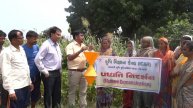Safe and readily available water is important for public health—[Safe Drinking-water - WHO]—**Hindi
Safe and readily available water is important for public health—[Safe Drinking-water - WHO]—**Hindi Information Video
Drinking-water
Key facts
In 2017, 71% of the global population (5.3 billion people) used a safely managed drinking-water service – that is, one located on premises, available when needed, and free from contamination.
90% of the global population (6.8 billion people) used at least a basic service. A basic service is an improved drinking-water source within a round trip of 30 minutes to collect water.
785 million people lack even a basic drinking-water service, including 144 million people who are dependent on surface water.
Globally, at least 2 billion people use a drinking water source contaminated with faeces.
#SafeDrinkingwater
Contaminated water can transmit diseases such diarrhoea, cholera, dysentery, typhoid, and polio. Contaminated drinking water is estimated to cause 485 000 diarrhoeal deaths each year.
By 2025, half of the world’s population will be living in water-stressed areas.
In least developed countries, 22% of health care facilities have no water service, 21% no sanitation service, and 22% no waste management service.
Introduction
Safe and readily available water is important for public health, whether it is used for drinking, domestic use, food production or recreational purposes. Improved water supply and sanitation, and better management of water resources, can boost countries’ economic growth and can contribute greatly to poverty reduction.
In 2010, the UN General Assembly explicitly recognized the human right to water and sanitation. Everyone has the right to sufficient, continuous, safe, acceptable, physically accessible, and affordable water for personal and domestic use.
Drinking water services
Sustainable Development Goal target 6.1 calls for universal and equitable access to safe and affordable drinking water. The target is tracked with the indicator of “safely managed drinking water services” – drinking water from an improved water source that is located on premises, available when needed, and free from faecal and priority chemical contamination.
In 2017, 5.3 billion people used safely managed drinking-water services – that is, they used improved water sources located on premises, available when needed, and free from contamination. The remaining 2.2 billion people without safely managed services in 2017 included:
1.4 billion people with basic services, meaning an improved water source located within a round trip of 30 minutes
206 million people with limited services, or an improved water source requiring more than 30 minutes to collect water
435 million people taking water from unprotected wells and springs
144 million people collecting untreated surface water from lakes, ponds, rivers and streams.
Sharp geographic, sociocultural and economic inequalities persist, not only between rural and urban areas but also in towns and cities where people living in low-income, informal, or illegal settlements usually have less access to improved sources of drinking-water than other residents.
Economic and social effects
When water comes from improved and more accessible sources, people spend less time and effort physically collecting it, meaning they can be productive in other ways. This can also result in greater personal safety by reducing the need to make long or risky journeys to collect water. Better water sources also mean less expenditure on health, as people are less likely to fall ill and incur medical costs, and are better able to remain economically productive.
With children particularly at risk from water-related diseases, access to improved sources of water can result in better health, and therefore better school attendance, with positive longer-term consequences for their lives.
Challenges
Climate change, increasing water scarcity, population growth, demographic changes and urbanization already pose challenges for water supply systems. By 2025, half of the world’s population will be living in water-stressed areas. Re-use of wastewater, to recover water, nutrients, or energy, is becoming an important strategy. Increasingly countries are using wastewater for irrigation – in developing countries this represents 7% of irrigated land. While this practice if done inappropriately poses health risks, safe management of wastewater can yield multiple benefits, including increased food production.
Options for water sources used for drinking water and irrigation will continue to evolve, with an increasing reliance on groundwater and alternative sources, including wastewater. Climate change will lead to greater fluctuations in harvested rainwater. Management of all water resources will need to be improved to ensure provision and quality.
In 2015 the two agencies jointly developed WASH FIT (Water and Sanitation for Health Facility Improvement Tool), an adaptation of the water safety plan approach.
Видео Safe and readily available water is important for public health—[Safe Drinking-water - WHO]—**Hindi автора Талантливые мастера
Видео Safe and readily available water is important for public health—[Safe Drinking-water - WHO]—**Hindi автора Талантливые мастера
Информация
10 марта 2025 г. 0:33:30
00:25:05
Похожие видео
 Method demonstration of installation of light trap
Method demonstration of installation of light trap re-make NARUTO SHIPPUDEN TRAP & DEAL WITH IT
re-make NARUTO SHIPPUDEN TRAP & DEAL WITH IT Мой "новый" трактор
Мой "новый" трактор Имруза нархохи Некси тайота Опель Вектра беҳтарин навор дустон 10.08.2022..
Имруза нархохи Некси тайота Опель Вектра беҳтарин навор дустон 10.08.2022.. #gogolevv #twitch.tv/gogolevv похож?
#gogolevv #twitch.tv/gogolevv похож? СВО-решила уехать на сво😂😂😂
СВО-решила уехать на сво😂😂😂 Агрессивный ремонт. День 43.
#ремонт #лестницасвоимируками #бюджетныйремонт
Агрессивный ремонт. День 43.
#ремонт #лестницасвоимируками #бюджетныйремонт Manitou MLT-X 735 120 LSU
Manitou MLT-X 735 120 LSU Ребёнок — подарок дыхания!
Ребёнок — подарок дыхания! Москва самый красивый город мира. Яндекс, ВК, ВДНХ, каток, вечное счастье
Москва самый красивый город мира. Яндекс, ВК, ВДНХ, каток, вечное счастье У ДАЛЬНОБОЙЩИКОВ ОТЛЕТЕЛО КОЛЕСО ПРЯМО НА ХОДУ! МУЛЬТИК в Scrap Mechanic
У ДАЛЬНОБОЙЩИКОВ ОТЛЕТЕЛО КОЛЕСО ПРЯМО НА ХОДУ! МУЛЬТИК в Scrap Mechanic Пурген - Севастополь, Арт бар Артерия (18.09.2022)
Пурген - Севастополь, Арт бар Артерия (18.09.2022) ОЛЬГА УРАЛОЧКА LIVE | Закон не писан нам! Заплатим хоть мильён! | Музыкальный обзор
ОЛЬГА УРАЛОЧКА LIVE | Закон не писан нам! Заплатим хоть мильён! | Музыкальный обзор 🪖Теткинское направление. На видео с ZALA можно заметить как горит техника противника. В данны...
🪖Теткинское направление. На видео с ZALA можно заметить как горит техника противника. В данны... 05-05-2025 Ваня
05-05-2025 Ваня Педагоги года Москвы 2025 | Александра Екомасова — финалист номинации «Педагог-дефектолог»
Педагоги года Москвы 2025 | Александра Екомасова — финалист номинации «Педагог-дефектолог» TDM - I'm An Albatraoz | Bass boosted trance | trap dance music Remix | (1020p)
TDM - I'm An Albatraoz | Bass boosted trance | trap dance music Remix | (1020p) Я НАШЛА ГРОБ ДОМОВОГО, и на нашла блокнот затерянной девочки...🆘😱
Я НАШЛА ГРОБ ДОМОВОГО, и на нашла блокнот затерянной девочки...🆘😱 Backhoe vs Excavator real competition
Backhoe vs Excavator real competition Фатехпур-Сикри — Индия(Золотой треугольник)
Фатехпур-Сикри — Индия(Золотой треугольник)
